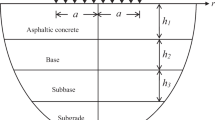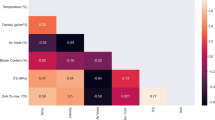Abstract
Pavement performance evaluation based on modulus is crucial for controlling the overall performance of pavements and decisions making throughout the pavement’s life cycle. Falling weight deflectometer (FWD) tests are commonly employed to collect deflection data, which is subsequently back-calculated to get each layer’s modulus. However, existing studies lack a complete framework for incorporating the bedrock condition in the back-calculation process. Here, an integrated process of pavement performance evaluation utilizing FWD tests is proposed, and the focus is on the classification of bedrock condition by modern classification algorithms (BPNN, MLP, SVM, and RF) to determine the presence or absence of bedrock and its depth range. The implementation of classification process allows for the inclusion of bedrock influence in the back-calculation process, thereby improving the accuracy of modulus results. Results from the four classification algorithms reveals that RF is the most suitable for classifying bedrock depth, exhibiting superior overall performance. The proposed integrated back-calculation process enables a comprehensive and objective evaluation of pavement structural performance, providing a valuable framework for informed decisions making.









Similar content being viewed by others
References
Picoux, B., El Ayadi, A., Petit, C.: Dynamic response of a flexible pavement submitted by impulsive loading. Soil Dyn. Earthq. Eng. 29(5), 845–854 (2009). https://doi.org/10.1016/j.soildyn.2008.09.001
Fathi, S., Mehravar, M., Rahman, M.: Development of FWD based hybrid back-analysis technique for railway track condition assessment. Transp. Geotech. 38, 100894 (2023). https://doi.org/10.1016/j.trgeo.2022.100894
Zheng, L., Hai-lin, Y., Wan-ping, W., Ping, C.: Dynamic stress and deformation of a layered road structure under vehicle traffic loads: experimental measurements and numerical calculations. Soil Dyn. Earthq. Eng. 39, 100–112 (2012). https://doi.org/10.1016/j.soildyn.2012.03.002
Park, B., Cho, S., Rahbar-Rastegar, R., Nantung, T.E., Haddock, J.E.: Prediction of critical responses in full-depth asphalt pavements using the falling weight deflectometer deflection basin parameters. Constr. Build. Mater. 318, 126019 (2022). https://doi.org/10.1016/j.conbuildmat.2021.126019
Al-Hunaidi, M.O.: Nondestructive evaluation of pavements using spectral analysis of surface waves in the frequency wave-number domain. J. Nondestruct. Eval. 15(2), 71–82 (1996). https://doi.org/10.1007/BF00729136
Fu, G.Z., Zhao, Y.Q., Zhou, C.J., Liu, W.Q.: Determination of effective frequency range excited by falling weight deflectometer loading history for asphalt pavement. Constr. Build. Mater. 235, 117792 (2020). https://doi.org/10.1016/j.conbuildmat.2019.117792
Zhao, Y., Cao, D., Chen, P.: Dynamic backcalculation of asphalt pavement layer properties using spectral element method. Road Mater. Pavement Des. 16(4), 870–888 (2015). https://doi.org/10.1080/14680629.2015.1056214
Wang, H., Li, M.Y.: Comparative study of asphalt pavement responses under FWD and moving vehicular loading. J. Transp. Eng. 142(12), 4016069 (2016). https://doi.org/10.1061/(ASCE)TE.1943-5436.0000902
Lee, S.W., Mahoney, J.P., Jackson, N.C.: Verification of backcalculation of pavement moduli, Transp. Res. Rec. 85–95 (1988)
Cauwelaert, F.V., Alexander, T.D., White, W.B.: Multilayer elastic problem for backcalculating layer moduli in pavement evaluation. Astm Special Tech. Publ. 1026, 171–188 (1989)
Scullion, T., Uzan, J., Paredes, M.: MODULUS: a microcomputer-based backcalculation system. Trans. Res. Record 1260, 180–191 (1990)
Anderson, M.: A data base method for backcalculation of composite pavement layer moduli, Astm Special Technical Publication (1989)
Khazanovich, L., Roesler, J.: DIPLOBACK: neural-network-based backcalculation program for composite pavements. Transp. Res. Rec. 1570, 143–150 (1997). https://doi.org/10.3141/1570-17
Fwa, T., Tan, C.Y., Chan, W.T.: Backcalculation analysis of pavement-layer moduli using genetic algorithms. Transp. Res. Rec. 1570, 134–142 (1997). https://doi.org/10.3141/1570-16
Rakesh, N., Jain, A.K., Reddy, M.A., Reddy, K.S.: Artificial neural networks-genetic algorithm based model for backcalculation of pavement layer moduli. Int. J. Pavement Eng. 7(3), 221–230 (2006). https://doi.org/10.1080/10298430500495113
Rezaei-Tarahomi, A., Kaya, O., Ceylan, H., Kim, S., Gopalakrishnan, K., Brill, D.R.: Development of rapid three-dimensional finite-element based rigid airfield pavement foundation response and moduli prediction models. Transp. Geotech. 13, 81–91 (2017). https://doi.org/10.1016/j.trgeo.2017.08.011
Deng, Y., Luo, X., Zhang, Y., Lytton, R.L.: Determination of complex modulus gradients of flexible pavements using falling weight deflectometer and artificial intelligence. Mater. Struct. 53(4), 100 (2020). https://doi.org/10.1617/s11527-020-01528-2
Deng, Y., Luo, X., Zhang, Y., Cai, S., Huang, K., Shi, X., Lytton, R.L.: Determination of flexible pavement deterioration conditions using long-term pavement performance database and artificial intelligence-based finite element model updating. Struct. Control. Health Monit. 28(2), e2671 (2021). https://doi.org/10.1002/stc.2671
Deng, Y., Zhang, Y., Shi, X.: Feasibility of determining asphalt pavement condition from falling weight deflectometer test and finite element model updating. Philos. Trans. Royal Soc. A 381(2254), 20220168 (2023). https://doi.org/10.1098/rsta.2022.0168
Deng, Y., Luo, X., Wang, H.: Backcalculation of damage density of in-service asphalt pavements using artificial intelligence-based finite element model updating. Fatigue Fract. Eng. Mater. Struct. 45(3), 671–686 (2022). https://doi.org/10.1111/ffe.13624
Burmister, D.M.: The general theory of stresses and displacements in layered soil systems. III. J. Appl. Phys. 16(5), 296–302 (2004). https://doi.org/10.1063/1.1707590
Cai, Y.C., Sangghaleh, A., Pan, E.: Effect of anisotropic base/interlayer on the mechanistic responses of layered pavements. Comput. Geotech. 65, 250–257 (2015). https://doi.org/10.1016/j.compgeo.2014.12.014
You, L., Yan, K., Hu, Y., Zollinger, D.G.: Spectral element solution for transversely isotropic elastic multi-layered structures subjected to axisymmetric loading. Comput. Geotech. 72, 67–73 (2016). https://doi.org/10.1016/j.compgeo.2015.11.004
Chang, D., Kang, Y.V., Roesset, J.M., Stokoe, K.H.: Effects of depth to bedrock on deflection basins obtained with dynaflect and falling weight deflectometer test. Transp. Res. Rec. 1355, 8–16 (1992)
Broutin, M.: Assessment of flexible airfield pavements using heavy weight deflectometers: development of a FEM dynamical time-domain analysis for the backcalculation of structural properties. In: Ecole des Ponts ParisTech, Paris (2010)
Wang, Y.J., Zhao, Y.Q., Zhang, M.Y., Fu, G.Z.: Influence of bedrock on the dynamic deflection response and dynamic back-calculation results of asphalt pavement: Insights from the numerical simulation of falling weight deflectometer tests. Constr. Build. Mater. 330, 127252 (2022). https://doi.org/10.1016/j.conbuildmat.2022.127252
Wang, Y.J., Zhao, Y.Q., Sun, Q., Fu, G.Z.: Influence of bedrock on viscoelastic responses and parametric back-calculation results for asphalt pavements and prediction of bedrock depth under FWD tests. Constr. Build. Mater. 377, 131158 (2023). https://doi.org/10.1016/j.conbuildmat.2023.131158
Romanoschi, S.A., Metcalf, J.B.: Effects of interface condition and horizontal wheel loads on the life of flexible pavement structures. Transp. Res. Rec. 1778(1), 123–131 (2001). https://doi.org/10.3141/1778-15
Kruntcheva, M.R., Collop, A.C., Thom, N.H.: Effect of bond condition on flexible pavement performance. J. Transp. Eng. 131(11), 880–888 (2005)
Yoo, P.J., Al-Qadi, I.L., Elseifi, M.A., Janajreh, I.: Flexible pavement responses to different loading amplitudes considering layer interface condition and lateral shear forces. Int. J. Pavement Eng. 7(1), 73–86 (2006). https://doi.org/10.1080/10298430500516074
Rebouças Santana, V., de Souza Almeida, M.S., Bressanin, H.W., Almeida Brito, J., Silva Costa, W.G., Da Costa São Mateus, M.D.S.: Effects of overload and layer interface condition on estimated flexible pavement lifespan: case study from BR-116/BA. Transp. Geotech. 34, 100762 (2022). https://doi.org/10.1016/j.trgeo.2022.100762
Cao, D.D., Zhao, Y.Q., Zhang, J.X., Jing, P., Yao, H.: Investigation of the interface condition influence on backcalculated layer properties. J. Trans. Eng. Part B: Pavements 147(3), 4021026 (2021). https://doi.org/10.1061/JPEODX.0000281
Deng, Y.J., Yang, Q.: Rapid evaluation of a transverse crack on a semi-rigid pavement utilising deflection basin data. Road Mater. Pavement Des. 20(4), 929–942 (2019). https://doi.org/10.1080/14680629.2018.1424026
Fu, G.Z., Wang, H., Zhao, Y.Q., Yu, Z.Q., Li, Q.: Non-destructive evaluation of longitudinal cracking in semi-rigid asphalt pavements using FWD deflection data. Struct. Control. Health Monit. 29(10), e3050 (2022). https://doi.org/10.1002/stc.3050
Fu, G.Z., Zhao, Y.Q., Wang, G.Z., Wei, J.C.: Evaluation of the effects of transverse cracking on the falling weight deflectometer data of asphalt pavements. Int. J. Pavement Eng. 23(9), 3198–3211 (2022). https://doi.org/10.1080/10298436.2021.1886295
Fu, G., Zhao, Y., Ong, G.P., Wang, Y., Lu, J.: Effects of transverse cracks on the backcalculated layer properties of asphalt pavements from non-destructive testing data. J. Nondestruct. Eval. 42(3), 69 (2023). https://doi.org/10.1007/s10921-023-00978-2
Wang, Y.J., Zhao, Y.Q.: Predicting bedrock depth under asphalt pavement through a data-driven method based on particle swarm optimization-back propagation neural network. Constr. Build. Mater. 354, 129165 (2022). https://doi.org/10.1016/j.conbuildmat.2022.129165
Yang, X., Guan, J., Ding, L., You, Z., Lee, V.C.S., Mohd Hasan, M.R., Cheng, X.: Research and applications of artificial neural network in pavement engineering: a state-of-the-art review. J. Traffic Trans. Eng. (English Edition) 8(6), 1000–1021 (2021). https://doi.org/10.1016/j.jtte.2021.03.005
Rumelhart, D.E., Hinton, G.E., Williams, R.J.: Learning representations by back-propagating errors. Nature 323(6088), 533–536 (1986). https://doi.org/10.1038/323533a0
Hassoun, M.H.: Fundamentals of artificial neural networks. Proc. IEEE 84(6), 906 (1996). https://doi.org/10.1109/JPROC.1996.503146
Cano-Ortiz, S., Pascual-Muñoz, P., Castro-Fresno, D.: Machine learning algorithms for monitoring pavement performance. Autom. Constr. 139, 104309 (2022). https://doi.org/10.1016/j.autcon.2022.104309
Gong, H., Sun, Y., Shu, X., Huang, B.: Use of random forests regression for predicting IRI of asphalt pavements. Constr. Build. Mater. 189, 890–897 (2018). https://doi.org/10.1016/j.conbuildmat.2018.09.017
Rizzi, S.A., Doyle, J.F.: Spectral analysis of wave motion in plane solids with boundaries. J. Vib. Acoust. 114(2), 133–140 (1992). https://doi.org/10.1115/1.2930241
Doyle, J.F.: Wave propagation in structures: Spectral analysis using fast discrete Fourier transforms. Springer, New York (1997)
Rizzi, S.A., Doyle, J.F.: A spectral element approach to wave motion in layered solids. J. Vib. Acoust. 114(4), 569–577 (1992). https://doi.org/10.1115/1.2930300
Al-Khoury, R., Kasbergen, C., Scarpas, A., Blaauwendraad, J.: Spectral element technique for efficient parameter identification of layered media: Part II: Inverse calculation. Int. J. Solids Struct. 38(48–49), 8753–8772 (2001)
Al-Khoury, R., Scarpas, A., Kasbergen, C., Blaauwendraad, J.: Spectral element technique for efficient parameter identification of layered media. Part III: viscoelastic aspects. Int. J. Solids Struct. 39(8), 2189–2201 (2002). https://doi.org/10.1016/S0020-7683(02)00079-3
Li, M.Y., Wang, H., Xu, G.J., Xie, P.Y.: Finite element modeling and parametric analysis of viscoelastic and nonlinear pavement responses under dynamic FWD loading. Constr. Build. Mater. 141, 23–35 (2017). https://doi.org/10.1016/j.conbuildmat.2017.02.096
D.E. Rumelhart, J.L. Mcclelland, (1986) Parallel distributed processing, Encyclopedia of Database Systems, 45–76.
Ehteram, M., Ahmed, A.N., Ling, L., Fai, C.M., Latif, S.D., Afan, H.A., El-Shafie, A.: Pipeline scour rates prediction-based model utilizing a multilayer perceptron-colliding body algorithm. Water 12(3), 902 (2020)
Aydın, B., Yağuzluk, S., Açıkkar, M.: Prediction of landslide tsunami run-up on a plane beach through feature selected MLP-based model. J. Ocean Eng. Sci. (2022). https://doi.org/10.1016/j.joes.2022.05.007
Cortes, C., Vapnik, V.: Support-vector networks. Mach. Learn. 20(3), 273–297 (1995). https://doi.org/10.1023/A:1022627411411
Chapelle, O., Haffner, P., Vapnik, V.N.: Support vector machines for histogram-based image classification. IEEE Trans. Neural Netw. 10(5), 1055–1064 (1999)
Chang, C.C., Lin, C.J.: LIBSVM: a library for support vector machines. Acm Trans. Intell. Syst. Technol. 2(3), 27 (2011). https://doi.org/10.1145/1961189.1961199
Breiman, L.: Random forests. Mach. Learn. 45, 5–32 (2001)
De-Prado-Gil, J., Palencia, C., Silva-Monteiro, N., Martínez-García, R.: To predict the compressive strength of self compacting concrete with recycled aggregates utilizing ensemble machine learning models. Case Stud. Constr. Mater. 16, e1046 (2022)
Naser, A.H., Badr, A.H., Henedy, S.N., Ostrowski, K.A., Imran, H.: Application of multivariate adaptive regression splines (MARS) approach in prediction of compressive strength of eco-friendly concrete. Case Stud. Constr. Mater. 17, e1262 (2022)
Zhou, Y., Liu, Y., Wang, N., Han, X., Li, J.: Partial discharge ultrasonic signals pattern recognition in transformer using BSO-SVM based on microfiber coupler sensor. Measurement 201, 111737 (2022). https://doi.org/10.1016/j.measurement.2022.111737
Funding
This work was supported by the National Natural Science Foundation of China (Grant No.51678114), Urumqi Transportation Research Project (Grant No.JSKJ201806), and Shanxi Province Transportation Research Project (Grant No.19-JKKJ-4). The authors gratefully acknowledged their financial support.
Author information
Authors and Affiliations
Contributions
YW: Conceptualization, Methodology, Data curation, Formal analysis, Writing-original draft, Writing-review and editing; YZ: Conceptualization, Resources, Supervision, Funding acquisition; GF: Methodology, Writing-original draft, Writing-review and editing.
Corresponding author
Ethics declarations
Conflict of interest
The authors declare no competing interests related to this work.
Ethical Approval and Consent to Participate
Not applicable.
Consent for Publication
All the authors have agreed for publication.
Additional information
Publisher's Note
Springer Nature remains neutral with regard to jurisdictional claims in published maps and institutional affiliations.
Rights and permissions
Springer Nature or its licensor (e.g. a society or other partner) holds exclusive rights to this article under a publishing agreement with the author(s) or other rightsholder(s); author self-archiving of the accepted manuscript version of this article is solely governed by the terms of such publishing agreement and applicable law.
About this article
Cite this article
Wang, Y., Zhao, Y. & Fu, G. Machine Learning Models for Bedrock Condition Classification in Pavement Structure Evaluation: A Comparative Study. J Nondestruct Eval 43, 33 (2024). https://doi.org/10.1007/s10921-024-01048-x
Received:
Accepted:
Published:
DOI: https://doi.org/10.1007/s10921-024-01048-x




